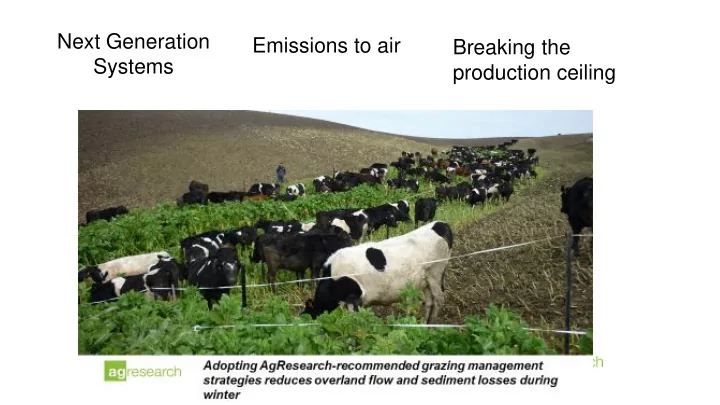

Next Generation Emissions to air Breaking the Systems production ceiling
Our Land and Water National Science Challenge Toitū te Whenua Toiora te Wai Next Generation Systems Robyn Dynes , Anita Wreford, Alan Renwick, Warren King, Paul Johnstone, Peter Clinton, Carolyn Hedley, Grant Edwards.
Why science in NGS • Development, redesign, New technologies • Science supporting innovation • Business decision • Which solutions have comparative advantage??
Weighting of each alternative under each criteria – sheep dairy example Capital investment Greenhouse Gas Profit/ha 1.00 Building Return on Investment Water 0.90 Payback Period 0.80 Animal Welfare Variability in Profit 0.70 Food safety Income diversification 0.60 0.50 Health and Safety Scale of market 0.40 Confidence Ability to capture value added 0.30 0.20 State of Technology Variability of supply 0.10 0.00 Supply chain strength Available Advisory support Supply chain strength Extent system is proven Availability of Labour State of my knowledge Local Employment Similarity to current system Conditions of Employment Env Stewardship Noise/Visual Impact Disease (Ecoli etc) Cultural Values P Losses Value Distribution (multiplier effect) GHG Emissions Quality of Life Erosion/Sediment Nitrate Leaching
What are the benefits from partnering with NGS? Science Business • Investment priorities • Certainty of investment • Less risk Challenge science System reset Impact per $ spent Industry Farm optimisation • Consistency of desired product • Valued NZ brand • Shifting culture and performance Aligned science Mitigation Time
Next Generation Systems: partnerships with innovators • Corporate farming : redesigning systems within nutrient limits • Corporate farming:- diversifying portfolio • Maori: iwi and collectives exploring alternatives
Next Generation Systems: case studies of optimised systems • Value chain – Taupo beef • Precision Agriculture - Greenvale pastures • Continuous-harvest forestry • Iwi – supply chain development • ????
Background to dairy system studies Previous Modelling More efficient systems based on 5-point plan: P21 Phase II 1.High BW lower SR 2.NI + reduced N fert Dairy systems trials 3.Reduce replacements incorporating (parts of) this 5- 4.High energy/low N point plan: 5.Stand-off/housing a) Waikato (1, 2, 3, 4, 5) b) Canterbury (1, 2, 3, 4) c) South Otago (2, 3, 4, 5) NZAGRC Integrated Farm Evaluate and demonstrate Systems – Dairy feasibility, practicality, financial returns, and other Evaluate and demonstrate environmental impacts of a GHG emissions intensity range of pastoral systems 20 March 2019 | 8
Improved efficiency systems 5-point plan Waikato Canterbury South Otago OPT RES 1. Higher breeding worth lower SR 2. Reduced N fertiliser 3. Reduced replacement rates Grain Diverse pasture Cereal 4. High energy/low N Fodder beet 5. Stand-off/housing 20 March 2019 | 9
Approach To apply the models in practice: a farm systems evaluation of practices that reduced GHG emissions intensity in modelling studies. Can’t measure GHG losses from entire system! Instead: Use ‘Inventory’ type 1. calculations 2. Combined with targeted CH 4 and N 2 O measurements ‘Source’ detailed systems 3. data from P21 partners 7 Programme Integrated Farm systems Outcome/Impact Area Dairy Systems
Achievements 1. Targeted measurements to obtain systems specific emission factors for combinations of farm practices within practical systems 2. Calculated relevant GHG footprint for systems comparisons • Provided a wider systems analysis added GHG to $$, environmental losses to water. Key message: to demonstrate impact of changed practices must have accurate and relevant GHG emissions data 7 Programme Integrated Farm systems Outcome/Impact Area Dairy Systems
Canterbury (232 ha): including off-farm emissions $1,555* *Operating profit ($/ha MP) @ pay-out of $5.10/kg MS $2,175* Off-farm fertiliser Off-farm grain CH 4 – WC total CH 4 – MP total N 2 O – WC total N 2 O – MP total Low SR High SR Low SR High SR
Future Farm Systems: partnership model Farmers: Farmer, Industry, Rural professionals and Researchers Co-development towards a shared problem - shared solutions • New farm systems analysis tool • Key client value developed • Project management role • Farm Systems research • Relationships with science ‘grounded’ on commercial farms • Demonstrating ‘value’ of and sector component research • Greater impact from science Joint benefits: • Publications • Exposure • Value/Impact
Future Farming Systems - Dairy The Goal: Additional 2 t DM/ha more (considered very difficult) Where: Rakaia Island Dairy Who: AgResearch science expertise in farm systems, pastures, pests, disease, soils and Ravensdown staff 20/03/2019 Sores and Supply Conference July 2015
Farming system – analysis using yield mapping as a tool Identified potential leverage points – pasture variability
Differential P applications within paddocks Leverage point: irrigation Rate of water application (mm)
Leverage Point: irrigation Rate of water application (mm) Component research and AgResearch Science to assess key leverage points
Leverage Point: grass grub 90 grass grub
Recommend
More recommend